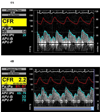Microvascular coronary dysfunction in women: pathophysiology, diagnosis, and management
- PMID: 21723447
- PMCID: PMC3132073
- DOI: 10.1016/j.cpcardiol.2011.05.002
Microvascular coronary dysfunction in women: pathophysiology, diagnosis, and management
Abstract
Women exhibit a greater symptom burden, more functional disability, and a higher prevalence of no obstructive coronary artery disease compared to men when evaluated for signs and symptoms of myocardial ischemia. Microvascular coronary dysfunction (MCD), defined as limited coronary flow reserve and/or coronary endothelial dysfunction, is the predominant etiologic mechanism of ischemia in women with the triad of persistent chest pain, no obstructive coronary artery disease, and ischemia evidenced by stress testing. Evidence shows that approximately 50% of these patients have physiological evidence of MCD. MCD is associated with a 2.5% annual major adverse event rate that includes death, nonfatal myocardial infarction, nonfatal stroke, and congestive heart failure. Although tests such as adenosine stress cardiac magnetic resonance imaging may be a useful noninvasive method to predict subendocardial ischemia, the gold standard test to diagnose MCD is an invasive coronary reactivity testing. Early identification of MCD by coronary reactivity testing may be beneficial in prognostication and stratifying these patients for optimal medical therapy. Currently, understanding of MCD pathophysiology can be used to guide diagnosis and therapy. Continued research in MCD is needed to further advance our understanding.
Copyright © 2011 Mosby, Inc. All rights reserved.
Figures




References
-
- Reis Steven E, Holubkov Richard, Smith AJ Conrad, et al. Coronary microvascular dysfunction is highly prevalent in women with chest pain in the absence of coronary artery disease: Results from the NHLBI WISE study. Am Heart J. 2001;141(5):735–741. - PubMed
-
- Diver DJ, Bier JD, Ferreira PE, et al. Clinical and arteriographic characterization of patients with unstable angina without critical coronary arterial narrowing (from the TIMI-IIIA Trial) Am. J. Cardiol. 1994;74(6):531–537. - PubMed
-
- Noel Bairey Merz C, Eteiba W, Pepine C, Johnson B, Shaw L, Kelsey S. Cardiac syndrome X: Relation to microvascular angina and other conditions. Current Cardiovascular Risk Reports. 2007;1(2):167–175.
-
- Sharaf BL, Pepine CJ, Kerensky RA, et al. Detailed angiographic analysis of women with suspected ischemic chest pain (pilot phase data from the NHLBI-sponsored Women's Ischemia Syndrome Evaluation [WISE] study angiographic core laboratory) The American Journal of Cardiology. 2001;87(8):937–941. - PubMed
-
- Kaski JC, Rosano GM, Collins P, Nihoyannopoulos P, Maseri A, Poole-Wilson PA. Cardiac syndrome X: clinical characteristics and left ventricular function. Long-term follow-up study. J. Am. Coll. Cardiol. 1995;25(4):807–814. - PubMed
Publication types
MeSH terms
Substances
Grants and funding
LinkOut - more resources
Full Text Sources

